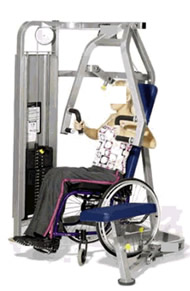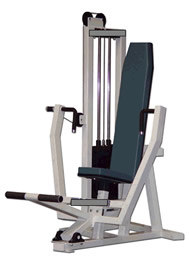Universal Design of Fitness Equipment Standards
Seanna L. Hurley, MS and Peter W. Axelson, MSME
Beneficial Designs, Inc., Minden, NV
Abstract
This project is developing uniform standards for the universal design of fitness equipment for the US as part of the RERC RecTech. RecTech’s goal is to improve recreation access, participation, and adherence for people with disabilities in order to improve health and function through exercise. RecTech has facilitated the collaboration of Beneficial Designs (BD) and the Inclusive Fitness Initiative (IFI) to harmonize the Universal Design of Fitness Equipment Guidelines initially developed by BD for the US through an NIH Phase I grant and those developed by the IFI for the UK. These standards will be applicable internationally and enable fitness equipment manufacturers to more effectively design equipment that can be used by people of all abilities, provide fitness centers with a reference when selecting fitness equipment, and allow people with disabilities to identify which equipment best meets their personal needs. Mainstream universal design fitness equipment increases access and decreases cost.
Keywords
ASTM standard; fitness equipment; access; universal design
Background
The Americans with Disabilities Act (ADA) entitles equal opportunity for individuals with disabilities, including physical, sensory and cognitive. ADA Title III applies to public accommodations, thus requiring access to public fitness centers and the equipment. Currently, mainstream fitness equipment found in public fitness centers is not easily accessible to many people with disabilities. For example, strength equipment tends to have non-removable seats, high start weights, high weight increments, and non-accessible weight adjustment mechanisms (Figure 1). These barriers prevent many people with disabilities from exercising in public fitness centers. They have to go to specialized rehabilitation centers in order to find accessible fitness equipment, which has both financial and social implications. Specialized rehabilitation fitness equipment is more expensive than mainstream fitness equipment and typically found only in rehabilitation facilities, which are not as commonly found or open to the general public as public fitness centers. Incorporating simple universal design principles can increase mainstream fitness equipment access to a much broader population, including those with disabilities (Figure 2). Universal design for fitness equipment standards will provide objective information and promote more inclusive fitness equipment in the mainstream market. Mainstream accessible fitness equipment will increase access and decrease cost of exercise for people with disabilities and allow exercise with family and friends.
 Figure 2. Accessible Chest Press (Click for larger view)
Figure 2. Accessible Chest Press (Click for larger view) Methods
The American with Disabilities Act Accessibility Guidelines for Buildings and Facilities were reviewed for all specifications that would be applicable to fitness equipment accessibility, for example, seat height, handrail dimensions, and controls and operating mechanisms (1). In addition, applicable ASTM (US) and EN (European) standards were reviewed to ensure harmonization between standards as best as possible (Table 1). Stakeholders representing manufacturers, exercise professionals, disability experts, facility operators, and researchers were then surveyed to evaluate this set of specifications in order to develop the initial Universal Design of Fitness Equipment Guidelines through an NIH Phase I grant through Beneficial Designs, Inc. The survey identified features that would make mainstream strength and cardio fitness equipment more accessible and safer to a broader population. For example, a logo spanning the length of a running treadmill belt was identified as a simple way to make the moving belt more visible to those with hearing impairments, low vision or vision impairments, thus minimizing the hazard of accidentally stepping onto a moving belt. A similar process took place independently through the IFI in the UK (2).
Applicable US Standards |
Applicable European Standards |
ASTM: F 1250 – 00 Standard Safety Specification for Stationary Exercise Bicycles |
DIN EN 957-1: Stationary training equipment Part 1: General safety requirements and test methods |
ASTM: F 1749 – 02 Standard Specification for Fitness Equipment and Fitness Facility Safety Signage and Labels |
DIN EN 957-4: Stationary training equipment – Additional specific safety requirements and test methods for strength training benches |
ASTM: F 2106 – 03 Standard Test Methods for Evaluating Design and Performance Characteristics of Motorized Treadmills |
SS EN 957-7: Stationary training equipment – Part 7: Rowing machines, additional specific safety requirements and test methods |
ASTM: F 2115 – 05 Standard Specification for Motorized Treadmills |
SS EN 957-8: Stationary training equipment – Part 8: Steppers, stairclimbers and climbers – Additional specific safety requirements and test methods |
ASTM: F 2277 – 03 Standard Test Methods for Evaluating Design and Performance Characteristics of Selectorized Strength Equipment |
DIN EN 957-9: Stationary training equipment Part 9: Elliptical trainers – Additional specific safety requirements and test methods |
ASTM: F 2216 – 05 Standard Specification for Selectorized Strength Equipment |
|
ASTM: F 2276 – 05 Standard Specification for Fitness Equipment |
|
BD and the IFI worked through RecTech to harmonize the two sets of fitness equipment guidelines. A harmonization score was developed to track progress: 1= equivalent (specifications are the same); 2= similar (the specifications are both objective or both subjective but differ to some degree); 3= not equal (one specification is objective while the other is subjective); and X= either US or UK is missing the specification
A series of meetings were held to cross-reference each specification between the UK and the US and code them accordingly. Then a series of meetings were held in order to work through the criteria that differed (2s, 3s, and Xs). Each criteria were independently analyzed as to their origin and revised until the two criteria were in agreement whenever possible. Where agreement was not possible due to a lack of data, research variables were flagged for future study.
Key stakeholders presented and promoted one set of uniform guidelines to the ASTM F08.30 Fitness Products Committee.
Results
Survey results and existing standards provided the basis for the Universal Design of Fitness Equipment Guidelines for the US. In comparing this base document to the Inclusive Fitness Initiative Guidelines for the UK, initial results from the harmonization scores were 18 specifications scoring 1 (equivalent), 110 specifications scoring 2 (similar), 30 specifications scoring 3 (not equal), and 108 specifications that were missing from either the US or UK guidelines. The series of phone conferences resulted in a uniform draft standard that was presented to the ASTM F08.30 Fitness Product Committee for the new work item New Guide for Inclusive Fitness Equipment Design. ASTM is now developing this document as an ASTM standard.
Stakeholders identified the top three access issues for cardio equipment as: minimal initial speed/resistance, flexible/multiple stop button position, and easy access for getting on/off. The following specifications that are currently under development are examples of how these access issues are being addressed: Treadmill maximum default start speed shall be no greater than 1.0 kmph (0.6 mph); Power driven equipment shall have a kill cord emergency stop or other hands free safety stop; and Mount/dismount should be possible from the maximum number of approach positions (e.g. front/rear/side) and avoiding left/right bias where practicable.
Stakeholders identified the top three access issues for strength equipment as: adjustable/removable seats, making adjustments from the exercise position, and minimal initial resistance/smaller weight increments. The following specifications that are currently under development are examples of how these access issues are being addressed: All upper body exercise equipment for which a seat is provided shall allow the seat to be re/moved to permit users to exercise from their wheelchair; All controls and adjustments should be accessible (within reach) to the user when mounted on the equipment; and Chest presses shall have a maximum start weight of 7.5 kg (16.5 lb) with a maximum incremental weights of 2.5 kg (5.5 lb).
Design variables identified that require further research were: the use of auditory feedback, method for determining color contrast in the field, static grip handle shape and diameter, contoured surface support shape and material, treadmill step-on height, identify an international anthropometric data set, determine how to measure push/pull/twist mechanisms and specify the ideal force, and the effects on a wheelchair when a person lifts weights from their wheelchair.
Discussion
Universal design of fitness equipment standards will provide fitness equipment manufacturers with specific criteria for both strength and cardio equipment for designing more universal products. The standards will assist fitness centers in selecting fitness equipment that meets the needs of more of their clients. Fitness centers will also be able to clearly communicate the universal accessible features of their fitness equipment to people with disabilities so that they can identify which pieces of equipment best meet their personal needs. By increasing access to fitness equipment in public fitness facilities, people with disabilities will be more likely to join and adhere to a fitness program with their family and friends. These standards will be applicable internationally and decrease the potential for conflicting standards worldwide.
References
- US Access Board. (Sept. 2002). The American with Disabilities Act Accessibility Guidelines for Buildings and Facilities. Retrieved January 22, 2009, from http://www.access-board.gov/adaag/html/adaag.htm.
- Inclusive Fitness Initiative. (May 2006). Inclusive Fitness Initiative Equipment Standards - Phase II. Retrieved January 20, 2009, from http://www.inclusivefitness.org/images/categories/Stage_Two_Standards_Ed2_-_05.06.pdf.
Acknowledgement
This project is funded by the Rehabilitation Engineering Research Center on Rechtech through the National Institute on Disability and Rehabilitation Research under the US Department of Education grant #H133E070029. Phase I of this project was funded by the National Center for Medical Rehabilitation Research in the National Institute of Child Health and Human Development at the National Institutes of Health through Small Business Innovation Research Phase I grant # 1 R43 HD049236-01.
Author Contact Information:
Seanna Kringen, MS, Beneficial Designs, Inc., 2240 Meridian Blvd., Suite C, Minden, NV 89423
Office Phone (775) 783-8822, Email: seanna@beneficialdesigns.com
